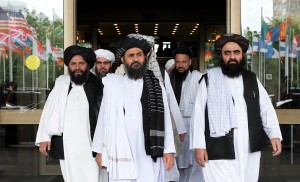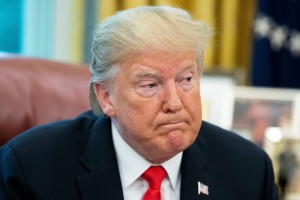Getting the
Afghanistan Peace Process
back on track
When US President Donald Trump suddenly called off talks with the Taliban on September 8, at a time when a settlement was in the offing, all hopes of a restoration of peace in Afghanistan appeared to have evaporated. Besides domestic compulsions, what was cited as another reason behind this stunning decision was that Taliban did not want peace as the group was unleashing violence even as talks were on and they did not want to accept the US condition that they accommodate the US-backed regime in Kabul in a settlement. However, after a brief hiatus, the process seems on track again as members of Taliban Political Commission (TPC) recently made their first-ever visit to Islamabad where the US Special Envoy for Afghanistan Reconciliation, Zalmay Khalilzad, was already present.
President Donald Trump’s suspension of US-Taliban talks has thrown US policy toward Afghanistan into disarray. Beginning in late 2018, and for the first time, the US had put at the forefront of its policy the aim to negotiate a political settlement of the conflict that includes a path for withdrawal of US forces. Nearly a year of intensive diplomacy had brought a draft US-Taliban agreement to the verge of signature. Then, on 7 September, Trump upended plans to seal the deal, tweeting that he had invited Taliban leaders to the Camp David presidential retreat and abruptly called off the event. He followed this news by declaring that talks between the US and the Taliban were “dead”, in effect scuttling the more important negotiations among Afghans that were to follow. In reality, however, Washington has no good alternative to reviving talks on the same basis as before the disruption. The US should pick up where it left off, concluding an agreement that sets the stage for an intra-Afghan peace process and thus offers hope of ending Afghanistan’s decades-long war.
Trump’s scuppering of talks has not improved Washington’s limited options in Afghanistan. First, the US could unilaterally withdraw its forces, irrespective of progress toward intra-Afghan negotiations. In this case, the conflict would continue, with violence likely intensifying as the Taliban seek to capitalise on US withdrawal and the anti-Taliban forces engage in an existential fight. Afghan government forces and allied militias could fracture, particularly if US and other funding declines. Afghanistan’s neighbours and other regional powers would likely back proxies in the ensuing multi-sided struggle.
Option two would see the US maintain current or somewhat reduced troop numbers, continue to back up Afghan government counter-insurgency operations in the hope of altering Taliban calculations, and continue to conduct counter-terrorism strikes and raids from inside the country. “Staying the course”, as this option is often dubbed, is also a recipe for war with no foreseeable end. Over the past decade, despite the US deploying many times more troops (at the peak) than it would plausibly commit today, the US and government forces have not defeated the Taliban. As US force levels have fallen, battlefield dynamics have steadily shifted in the insurgents’ favour. Afghans would pay a high price for either of the first two options. Already, the war in Afghanistan is the world’s deadliest.
The third and best option is to pursue a negotiated settlement of the conflict. This policy choice requires reopening talks with the Taliban as a next step. The Camp David debacle set back talks but probably not fatally; insurgent leaders have indicated that they are willing to return to negotiations. Diplomatic spadework would be needed to get the Afghan government to retreat from its critical rhetoric about the draft deal that burst into the open after the debacle, but this may need to wait for the dust to settle from the 28 September presidential election. The US also would need to rebuild regional powers’ confidence in its commitment to the negotiations route.
It has been only a year since the US has put pursuit of a deal at the centre of its Afghanistan policy. In that time, US Envoy Zalmay Khalilzad appears to have come close to securing an agreement that won sufficient Taliban concessions to justify the concessions made in return – particularly against the backdrop of a US political tide turning toward a troop pullout. The text is not public, but US officials say the deal sets out a timeline and conditions for the drawdown of US forces in return for Taliban pledges to cut ties with al-Qaeda, stop transnational terrorist groups operating from Afghanistan and, importantly, enter intra-Afghan talks. Because the Taliban has long rejected negotiating with the Afghan government, which it portrays as illegitimate, its pledge to do so surmounts a major obstacle to a peace process. The Taliban would not have made such a commitment had Washington not – after years of resistance – conceded to the group’s insistence on up-front direct talks with the US, resulting in agreement to withdraw forces.
Negotiations do not guarantee but at least offer some hope of ending the war. Washington would have to accept uncertainty over the timing of its military withdrawal. Troops and aid are the main sources of US leverage, and some US military presence, even if reduced, would give intra-Afghan negotiations the best prospects for success, though the US can continually assess its presence as intra-Afghan talks proceed. Whether the Taliban, Afghan government and other anti-Taliban powerbrokers can agree on what the Afghan state and security arrangements will look like is uncertain. Both sides may face resistance in their own ranks. But a US-Taliban agreement that paves the way for an Afghan peace process is the path more likely than any other to end the war and permit Washington to withdraw without prompting further chaos. The US has fought for almost two decades in Afghanistan yet prioritised peace talks for less than a year. Forsaking diplomacy now makes little sense. The sooner US political leaders allow their diplomats to get back to the table, the better.
Courtesy: International Crisis Group
The hard task ahead
Pakistan is making efforts to break the stalemate in Afghanistan caused by the suspension of talks between the Khalilzad-led US team of negotiators and the Afghan Taliban. While the USA appeared to be at the cusp of reaching a deal, it couldn’t be signed when US President Donald Trump, apparently disturbed by the Taliban’s jubilation over killing a US soldier, called off the talks. Another version ascribed his refusal to sign the deal to a perception that the brokered agreement could not be presented during the forthcoming Presidential elections as a victory for Trump.
Pakistan is required by the Afghan Taliban to persuade a mercurial Trump to sign the agreement. President Trump on the other hand wants Prime Minister Imran Khan to convince the highly determined and ruthless Afghan Taliban to agree to a ceasefire and enter into talks with the Afghan government. This will require Pakistan to motivate both to enter into a give-and-take. What will matter is how much clout Pakistan possesses with both sides.
While President Trump has promised to bring back US troops from the 18-year-long Afghan war, he also wants an agreement in hand that he can show to the US voters as evidence of US victory. The Afghan Taliban on the other would sign no document that by any flight of imagination could be interpreted as an instrument of surrender. Despite US insistence, they have refused to end the military operations aimed at capturing more territory while they continue to carry out terrorist attack to harass the Afghan administration. Meanwhile they have also refused to enter into talks with the Ghani government that they consider an American stooge.
Foreign Minister Qureshi hopes that the Taliban could be won over with the help of Pakistan’s agencies which may not be in consonance with the past events. The agencies hope that PM Imran Khan can win over President Trump, an equally problematic feat. This explains why the Foreign Minister and ISI chief jointly received the Taliban delegation at the Foreign Office. How much synergy both are capable of generating will become clear in weeks and months to come.
 Jahangir's World Times First Comprehensive Magazine for students/teachers of competitive exams and general readers as well.
Jahangir's World Times First Comprehensive Magazine for students/teachers of competitive exams and general readers as well.






